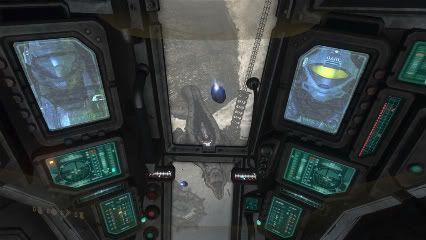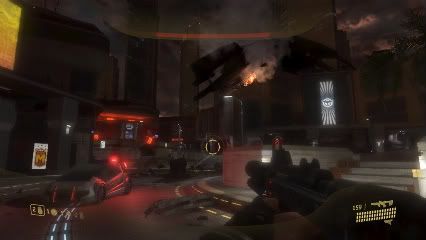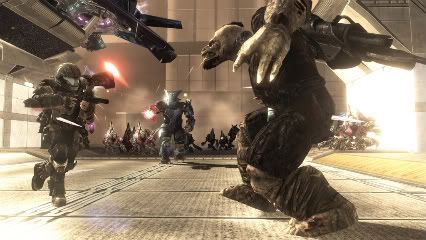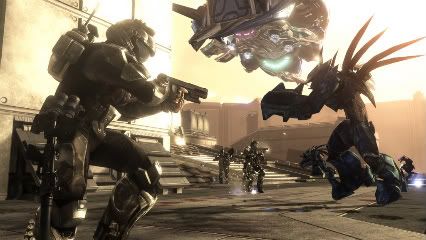
- Format: 360
- Unleashed: Out Now
- Publisher: Microsoft Game Studios
- Developer: Bungie Studios
- Players: 1-4 (Offline), 2-16 (Online)
- Site: http://www.bungie.net/
Halo 3: ODST is the deliberately-paced, stylized side-note to the Halo trilogy’s balls-to-the-wall sci-fi epic. It doesn’t feature any of the series’ main cast, and it often discourages combat in favour of stealth and investigation. Despite this (or because of it), ODST is the most well-told and unique entry in the series to date – a film noir-mystery featuring smoky saxophones, purple aliens, and 800-pound kebab salesmen.
The game focuses on a quintet of Orbital Drop Shock Troopers ordered to drop into the African city of New Mombasa. Think of them as the Navy SEALs of the Halo universe – they’re the best of the non-Master Chief best. You’re thrust into the role of The Rookie, about to be dropped from an orbiting spaceship down to the Earth’s surface. He’s a silent protagonist – one so unnecessarily mute that he seems to spoof that story-telling device.
The fall from space is thrilling – it’s an epic roller coaster ride disrupted by an explosion that leaves you unconscious and alone for 6 hours. In Halo time, these events take place after Halo 2′s Earth levels, shedding light on what went down while the Master Chief was saving the universe from the Covenant.
The first clue that you’re only human comes as you fall from the crash. The screen flashes bright red and the drop leaves you injured. It’s one of a slew of changes that make you feel less empowered. The result actually plays a lot more like the original Halo – you can’t dual-wield weapons, you can’t use equipment, you have a health bar, and you’re armed with an amazing pistol.
Depending on the difficulty level, these changes range from inconsequential to substantial. On easy and normal it’s business as usual, and the game doesn’t really feel any different. Bump it up to Heroic, and much more so Legendary, and you’ll be forced to take a more methodical pace. The conflicts are drawn out as you dance in and out of buildings and around cover, slowly wearing down squads of aliens.
The game begins in the dark, rainy city of New Mombasa. Your goal is to explore and investigate, avoiding Covenant squads wherever possible. This is where ODST takes its biggest departure from the Halo series proper. It’s an open environment where you can tackle missions non-linearly. The section stars the city’s Superintendent, an AI who uses road signs to subtly guide you to evidence of your squad-mates’ fates.
Once you find evidence, the Superintendent scans through city camera footage that takes you, the player, into the role of one of the other ODSTs, hours beforehand. These flashbacks feature straightforward and action-packed daytime set-pieces that act as counterparts to the Rookie missions.
If you’ve played Halo before, these flashbacks are business as usual, though spiced up with new characters that should be a treat for sci-fi fans. Nathan Fillion, Alan Tudyk, and Adam Baldwin of the beloved Firefly TV series all lend their voices to members of the ODST squad, even dropping the occasional line from that short-lived show. But that bonus only plays to so many fans, and for some, the ODSTs will come off as just another squad of grunts.
That’s part of the charm of ODST though – it’s less mainstream and more fan-catering than previous Halo games. It even dips into the expanded universe, with references typically reserved for the novels and ARGs.
These references add a lot of credence to ODST’s setting. New Mombasa feels more like a real environment than anything in previous Halo games. It’s aided by a side-story about a girl named Sadie, which you piece together by tapping into phones and ATMs around the city. This picture-book/radio play takes you through the city’s evacuation and a Dante’s Inferno-inspired exploration of human psyche in the face of apocalypse. It’s a little cheesy, and the characters are extreme (like the aforementioned kebab vendor, and a sex-crazed police captain), but that’s the point – it’s a stylized pulp companion to ODST’s main noir tale.
But for as much as ODST takes intelligent departures from previous Halo games, it still makes some of the same mistakes. The open world city, despite its Blade Runner-stylings and brilliant soundtrack, can become really draining. The quest for Sadie’s audio logs reveals that chunks of the city are reused. Repeating architecture leads to a complete loss of direction.
The flashback missions fare similarly – one level towards the end features drab hallways and the same enemies over and over. It’s the trap that every Halo game falls into at one point or another, but you’d hope Bungie would have learned by now.
Faults aside, ODST still has a lot to offer. As much as it’s a package for true fans it’s also a great Halo multiplayer starter kit. The second disc features every bit of Halo 3′s fantastic online multiplayer (including costly DLC maps).
On top of that you get Firefight mode, which pits four players against endless waves of Covenant. For Halo co-op players, this will be a dream come true. It’s wickedly fun, and thanks to Halo’s incredibly dynamic combat, tops similar modes in other shooters. The problem, and the reason it’s just a footnote and not the main focus of this review, is a lack of matchmaking. For as fun as the mode is, if you can’t track down friends, it won’t mean anything to you. With each passing week this mode is destined to fall further and further into obscurity. It’s especially sad considering Firefight is so fun Bungie could probably have charged £40 for that alone.
ODST is an excellent addition to the Halo series, and a special treat for fans who have experienced everything the series has to offer. With a like-minded and consistent group of friends, its Firefight mode could be your game of the year. It’s not going to be for everyone, but that’s what’s so great – this isn’t your focus-tested, mainstream-audience Halo game.
8/10
























Comments